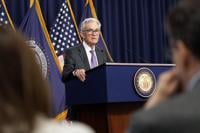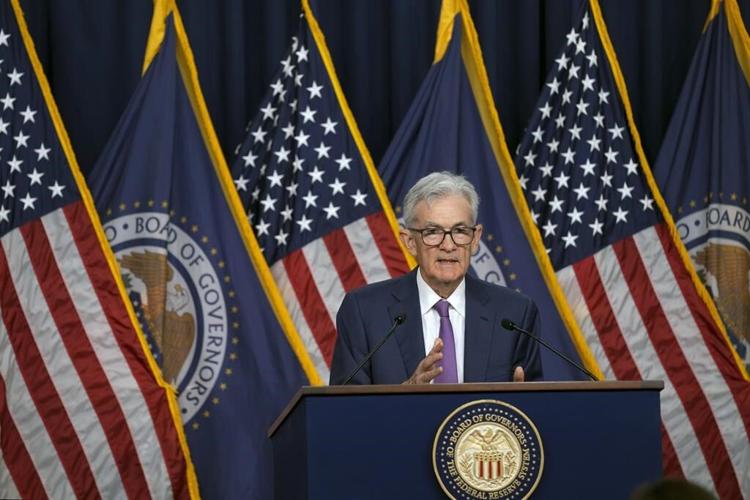WASHINGTON (AP) — The Federal Reserve on Wednesday emphasized that inflation has remained stubbornly high in recent months and said it doesn’t plan to cut interest rates until it has “greater confidence” that price increases are slowing sustainably to its 2% target.
The Fed issued its decision in a statement after its latest meeting, at which it kept its key rate at a two-decade high of roughly 5.3%. Several hotter-than-expected reports on prices and economic growth have recently undercut the Fed’s belief that inflation was steadily easing. The combination of high interest rates and persistent inflation has also emerged as a potential threat to President Joe Biden’s re-election bid.
“In recent months," Chair Jerome Powell said at a news conference, “inflation has shown a lack of further progress toward our 2% objective."
“It is likely that gaining greater confidence,” he added, "will take longer than previously expected.”
Powell did strike a note of optimism about inflation. Despite the recent setbacks, he said, “My expectation is that over the course of this year, we will see inflation move back down.”
Wall Street traders initially cheered the prospect that the Fed will cut rates at some point this year as well as Powell's comment that the Fed isn't considering reverting to rate increases to attack inflation.
“I think it’s unlikely that the next policy rate move will be a hike," he said.
Later, though, stock prices erased their gains and finished the day essentially unchanged from where they were before Powell's news conference.
Still, Powell sketched out a series of potential scenarios for the months ahead. He said that if hiring stayed strong and “inflation is moving sideways,” that “would be a case in which it would be appropriate to hold off on rate cuts.”
But if inflation continued to cool — or if unemployment rose unexpectedly — Powell said the Fed would likely be able to reduce its benchmark rate. Cuts would, over time, bring down the cost of mortgages, auto loans, and other consumer and business borrowing.
Those comments were “a signal that the (Fed) is a lot less confident that they know how policies are going to unfold over the course of this year,” said Jonathan Pingle, an economist at UBS. “We were all sort of hoping for an update on the committee's path forward. And instead what we got was, ‘We’re really not confident enough to tell you what our path forward is going to be.’ ”
The central bank’s overarching message Wednesday — that more evidence is needed that inflation is slowing to the Fed's target level before the policymakers would begin cutting rates — reflects an abrupt shift. As recently as their last meeting on March 20, the officials had projected three rate reductions in 2024, likely starting in June.
But given the persistence of elevated inflation, financial markets now expect just one rate cut this year, in November, according to futures prices tracked by CME FedWatch.
The Fed’s warier outlook stems from three months of data that pointed to chronic inflation pressures and robust consumer spending. Inflation has cooled from a peak of 7.1%, according to the Fed’s preferred measure, to 2.7%, as supply chains have eased and the cost of some goods has actually declined.
Average prices, though, remain well above their pre-pandemic levels, and the costs of services ranging from apartment rents and health care to restaurant meals and auto insurance continue to surge. With the presidential election six months away, many Americans have expressed discontent with the economy, notably over the pace of price increases.
On Wednesday, the Fed announced that it would slow the pace at which it’s unwinding one of its biggest COVID-era policies: Its purchase of several trillion dollars in Treasury securities and mortgage-backed bonds, an effort to stabilize financial markets and keep longer-term rates low.
The Fed is now allowing $95 billion of those securities to mature each month, without replacing them. Its holdings have fallen to about $7.4 trillion, down from $8.9 trillion in June 2022, when it began reducing them. On Wednesday, the Fed said it would, in June, reduce its holdings at a slower pace.
Instead of allowing $60 billion in Treasuries to roll off each month, it will allow just $25 billion. At the same time, it will continue letting $35 billion in mortgage-backed bonds mature each month.
By cutting back its holdings, the Fed could contribute to keeping longer-term rates, including mortgage rates, higher than they would be otherwise. That’s because as it reduces its bond holdings, other buyers will have to buy the securities instead, and rates might have to rise to attract the needed buyers.
The U.S. economy is healthier and hiring stronger than most economists thought it would be at this point. The unemployment rate has remained , the longest such streak since the 1960s. And while economic growth reached just a in the first three months of this year, consumer spending grew at a robust pace, a sign that the economy will keep expanding.
He also downplayed any concerns that the economy might be at risk of sliding into “stagflation” — a toxic combination of weak growth, high unemployment and elevated inflation that afflicted the United States during the 1970s.
“I was around for stagflation," Powell said, "and it was 10% unemployment, it was high-single-digit inflation. And very slow growth. Right now, we have 3% growth which is pretty solid growth, I would say, by any measure. And we have inflation running under 3%. ...I don’t see the ‘stag’ or the ‘flation,’ actually.”










































